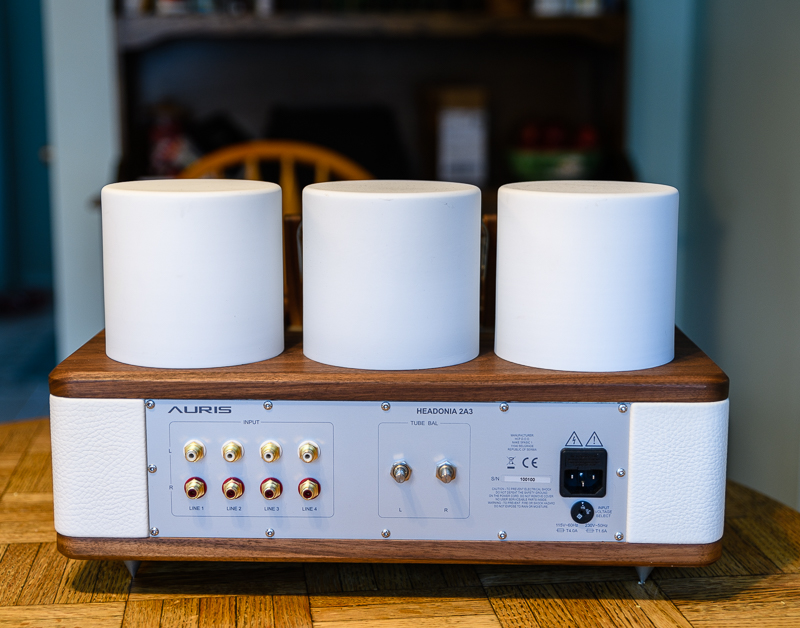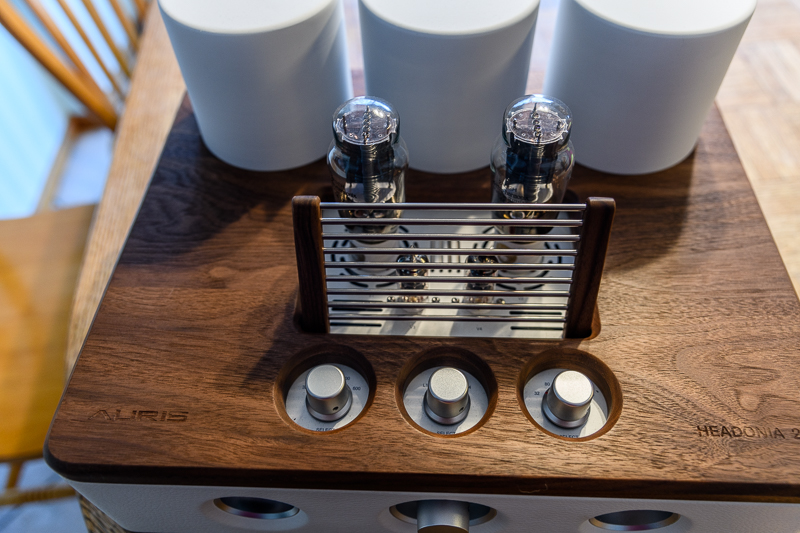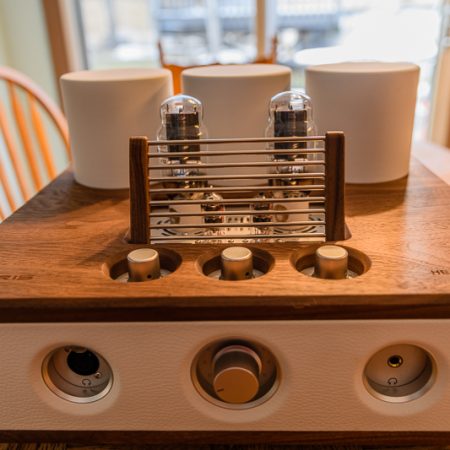While covering the CanJam NYC in February I had the first two aisles in the room to audition. I noticed Auris was in my self assigned aisles and had heard rumblings in the community prior to attending about the quality of their amplifiers. I decided to venture down the aisle and sat and listened to the Auris Headonia 2A3 tube amplifier and met Milomir Trosic the brand founder and CEO with his brand manager Tijana Marjanovic at the booth and they proceeded to show me the features of the amplifier and the system they were displaying at the show
Founding Auris in Serbia in 2013, Milomir has been busy building and designing amplifiers and other reference source products. The $9200 Headonia is the company’s reference amplifier designed and hand built in Serbia. The selection of parts is extensive as they use only those of the highest quality in the construction of their products.
Design
The Headonia is one of the most beautifully constructed amplifiers I have ever reviewed, with its wood crafted chassis wrapped in leather giving the Headonia fantastic eye appeal. The chassis is high quality aluminum and includes milled aluminum spiked feet. The design uses two Electro Harmonics Gold 2A3 along with two JJ ECC81 tubes.
There are four analog line inputs. The single ended design includes one single ended headphone input and one XLR 4 pin input in the design. The wood top is strikingly beautiful and adds a contemporary modern look to the amplifier. The rear of the amplifier also has a tube balance adjustment to fine-tune the sound of the tubes easily. The back screws allow you to tune the 2A3 tubes to remove any noise or hum if present. The Headonia puts out a robust 3 watts of power and is able to drive two headphones without any stress on the amplifier.

Individual adjustment the load impedance of each headphone can be made with just a turn of the chassis mounted selector switches with settings for 32, 80, 150, 300 and 600 Ohms. The impedance adjustment is nice, especially since the impedance load of different headphones vary and the selectors make the adjustment to match each headphone to the amplifier easy. The amplifier is built like a tank and weighs 50 lbs.
The Experience
Spending time in NY with the Headonia gave me a glimpse of what the amplifier was capable of producing. Anxiously awaiting its arrival, I was excited and looking forward to spending a couple of weeks with this artful design. The Headonia arrived and required UPS to deliver it in the house and it took both my wife Paula and I to lift it, unpack the amplifier and place it on the desktop in my listening room.
The setup was a breeze using the Nordost 3 meter Blue Heaven interconnect connected to the Marantz SA10 SACD/DAC for playing music discs and streaming Tidal lossless files. Installing the 4 tubes was simple once the amplifier was sitting on the desk. My music selection for the audition ranged from large scale dynamic recordings to acoustic and rock recordings.
The 2A3 direct heated triode is legendary in audiophile circles. The tube designed in 1932 is considered one of the best and most musical sounding triode tubes in existence. Rare NOS tubes can be quite expensive and even some new productions tubes from various boutique manufactures can run upwards of $200 tube. The current production’s 2A3 EH Gold tubes are only $75 tube and sound excellent.

The Headonia should be easy on tubes and provide long life as the amplifier was never hot to the touch. Unlike many other amps I have experienced that run hot throwing off a lot of heat and make the chassis too hot to touch, this amplifier runs cool and the chassis never gets hot. I suspect that the bias is not set too high as the amplifier was never hot when touching and that should prolong tube life. The underside of the chassis was also cool and the heat never was a distracting factor during my listening sessions.
The Grado PS2000E reference headphone was the first headphone I used. Knowing how good the PS 2000E was with tube amplification, I wanted to see how much more I could hear, after reviewing several high end amplifiers and recently finishing the Woo WA33 (review coming) another 2A3 design and my reference VPI 229D, I had a good idea of how the PS2000E sounds with tube amplification.
Heifetz Concertos on the RCA shaded dog SACD is a treat. The majestic sound of Fritz Reiner conducting the Chicago Symphony is a memorable performance. The speed of the Headonia was immediately noticeable as the dynamic range had outstanding speed and recreated the event masterfully. The Headonia had exceptional dynamics and excellent retrieval of detail. Tonality of instruments, especially the violin Heifetz was playing, was never anything but musical. Missing was any harshness or nasty sound that could be distracting or non musical. The magic of this recording is special and a treat to listen to on the Headonia as the amplifier never called attention to anything other than the music.
Listening to the Prokofiev Concerto 2 the sound had a delicacy and the instrument was captivating. I just got lost in the performance and the Headonia never made me loose sight of the music. The sound had clarity and transparency that was more alive and sounded less recorded than most other amps that I have heard this recording with. The amplifier just played and the 2A3 tube sound was sensational.
There was never any mechanical or electrical sound coming out of the amp. The PS2000E delivered exceptional musicality and never sounded bright or harsh. The sound was pure magic and the experience was breathtaking. The PS2000E was a complete revelation with this magnificent amplifier and the Marantz SA10 delivered the performance flawlessly. The synergy of the two components was exceptional.
The Susvara from Hifiman priced at $6000 can be difficult to drive with lesser sounding amplification. Using the Dana Lazuli single ended cable revealed more of what the Headonia was capable of doing, as the Susvara’s soundstage expanded dramatically. The combination of the Lazuli with the Susvara is truly exceptional.
Switching to the Copland “Fanfare for the Common Man” on the Reference Recording Label was more of a revelation. Many readers who follow my reviews through the years know this disc is my ultimate torture test for any amplifier. The dynamic range on this recording is endless. It is a test for any amplifier to successfully deliver the power that is needed for this recording, and over the years it has been at times so challenging many amplifiers collapsed when trying to recreate the dynamic swings of this recording. The Susvara added one more obstacle as the 82 dB headphones requires power and high current to deliver this performance majestically. The Susvara needs both high current and power to sound its best and once installed in Headonia I was more curious than ever to see if the amplifier could pass this difficult task of delivering the power and dynamics necessary for a flawless performance. I put in the disc and with a devilish grin on my face pushed the play button and waiting for the sound to come out.
Amazing layering in the soundstage was all there as the orchestra started playing the performance. The exceptional speed of the performance was all present with the Headonia doing the heavy work. The dynamic range soared and the tympani whacks started to rattle my brain while listening. The speed of the orchestra and the finale with the massive speed of the tympani and the performance was delivered with conviction as both the Susvara and the Headonia recreated this performance flawlessly and it had all the musicality intact. The delivery was spectacular and the Serbian masterpiece delivered exceptional speed with dynamics and all the thunder this recording produces. The amplifier and headphone sailed through this recording easily and had power to spare.
In the mood now for some more challenging experiences I decided to take the Audeze LCD 4 and use the balanced Heimdall cable from Nordost with the 4 pin XLR and set the load to 150 and leave the Susvara in with the load at 80 and drive both headphones. With my sly devilish smile on I continued with two headphones with the same challenging recording. Can the Headonia drive two headphones at the same time and not fall apart?
Using the same Copland track both headphones produced a similar performance. Amazingly the Headonia was able to drive both these headphones at the same time and still recreate the performance without a hitch. The amplifier never ran out of steam driving two planars at the same time on a challenging recording. There was no loss of speed or dynamics and the performance was still breathtaking.
The Hifiman HE1000 V2 is an easier load than the Susvara but still requires good amplification. The soundstage of the HE1000 series of headphones is one of the best in the industry, and listeners who love soundstage will love the Headonia. Tube amplifiers in my opinion do soundstage better than their solid-state counterpart and this 2A3 design is special with its soundstage delivery.
The Shostakovitch Symphony 5 on Reference Recordings won 2 Grammy awards, one for best Classical and the other for best engineered, and is another dynamic performance. The SACD on the Marantz SA10 was magnificent and the synergy between the amp and the player was playing the music masterfully. The Hifiman HE1000V2 soundstage had extraordinary front and back depth and the layering was all 3D. The orchestra had layering with exceptional air between the performers and each section of the orchestra was focused and I could visualize the performers in their own space. Imaging was another strong point of the Headonia and the musicality was indeed special.
Doug MacLeod’s vocal on “There’s A Time” once again showcased the Headonia ability to retrieve inner detail. The sound was alive with spectacular imaging and clarity. I could hear every syllable and his guitar playing was sensational. When closing my eyes I could see Doug sitting on the chair doing “Rosalie” and his in the room presence was as good as it gets and had that live you are there feeling. The sensational live feel of this performance was a magical journey into the music and storytelling of this legendary blues man both sensational and heart felt.
Listening to rock recordings gave me the same sense of musicality. Bon Jovi’s new album “This House is Not for Sale “ showcased the soundstage once again and using the Grado PS2000E once again, I was impressed with the dynamics and speed of the amplifier. The recording streaming from Tidal once again was pure musicality and the band delivered a sensation performance on this new album and the Headonia once again rose to the occasion and delivered outstanding dynamics and a rare transparency .
Summarizing the Experience
After spending two solid weeks of listening with the Auris Headonia I knew I was hearing something special. The Headonia was more of a musical instrument than a component and had my complete attention. The Serbian manufactured amplifier had exceptional speed and delivered large-scale recordings easily. The Headonia never faltered during playback of challenging recordings and always had me in awe of the spectacular musicality it was reproducing. I could hear inner detail in the recordings that were missing in other lesser components. The soundstage ranks as one of the best I have ever heard with pinpoint placements of the performers and non-faltering imaging.
The midrange had sensational performance with vocals. The clarity and transparency were all delivered flawlessly. Treble extension seemed to always soar and felt endless. The sound coming from the treble was always clean and never made trumpets or violins sound harsh, the tonality of instruments was simply exceptional. Bass had both slam and texture and the extension was excellent, detailed and when called for, it delivered thunder on the notorious Copland’s tympani in the Fanfare track.
There is a premium for this level of performance and the $9200 US price is not inexpensive. The cost of designing this product and the parts used to construct it do not come cheap. The beautifully constructed piece looks a like a modern work of art and paired with the performance I was able to get out of the Headonia, many including myself would conclude that this is an end game instrument for people looking for the best listening experience from headphones. This masterful instrument always delivered exceptional musicality.
When my audition period was coming to an end I was sad. I knew I would not be able to write the check to purchase the review sample. I also knew I would miss this instrument when it left my listening room. The sensational soundstage and the sound of the full-scale recordings with exceptional clarity and transparency would be missed. Music lovers looking for the ultimate in recreating the headphone listening experience will not be disappointed. The sound always delivered, no matter what obstacles I threw at it, it performed flawlessly. The Headonia is one of the best I have heard in delivering speed and dynamics with exceptional musicality. No matter what headphone I played, the Headonia made all of them perform at their highest level and was able to extract everything out of the transducers.
The Headonia is a musical instrument that delivers the ultimate in listening and a true end game design for people looking for the best in reproducing the musical experience. The Headonia merits consideration for the best in amplification design currently available. Achieving legendary status is not easy and rarely attainable, but after the way the Headonia performed, was able to step up every transducer it played, it is on its way to greatness and I predict legendary status. For many including myself this could be an end game solution, unfortunately I could not write the check and buy it, but gratefully I was able to have it in my listening system for a couple of weeks and the experience was memorable. Highly Recommended















Want to join discussion?
Feel free to contribute!